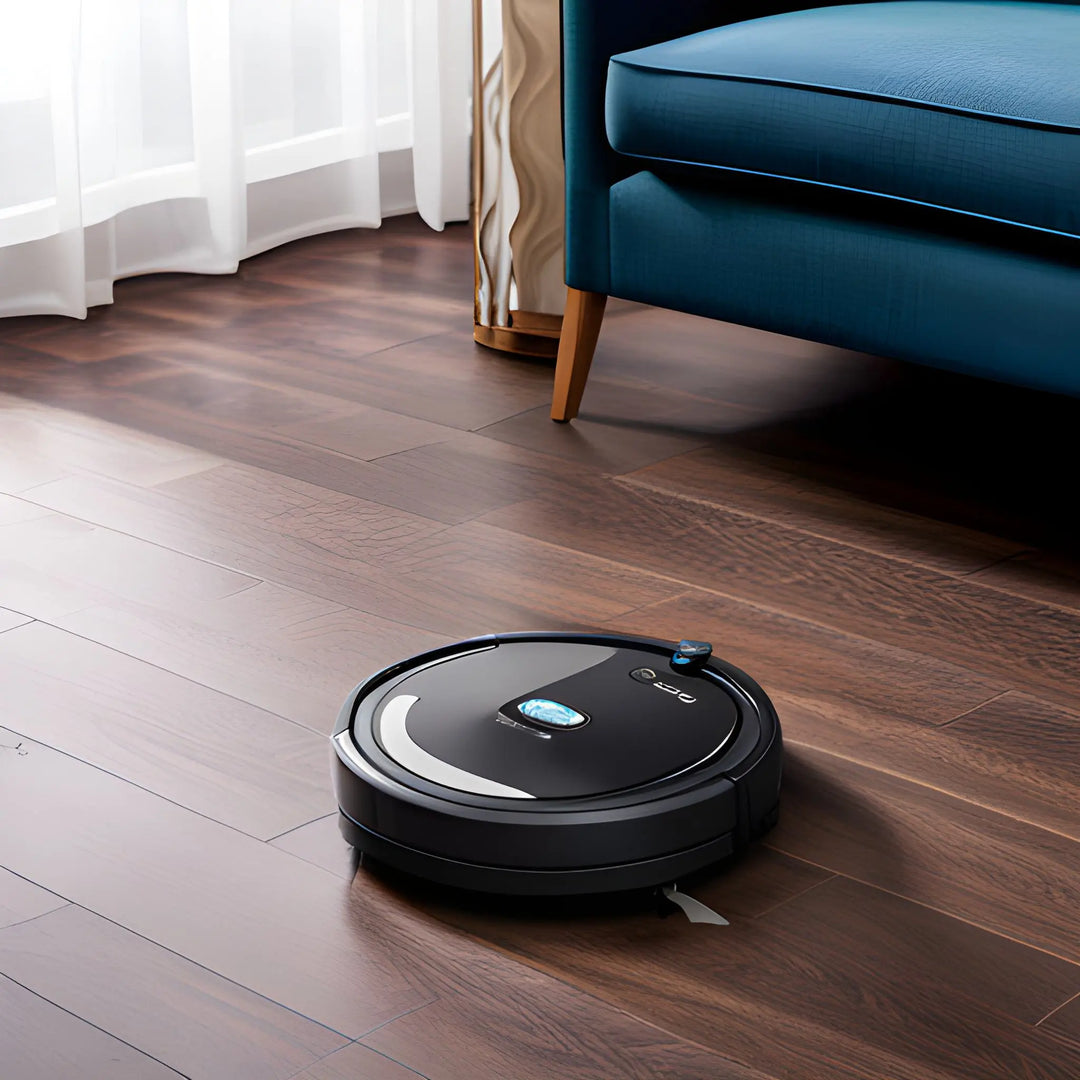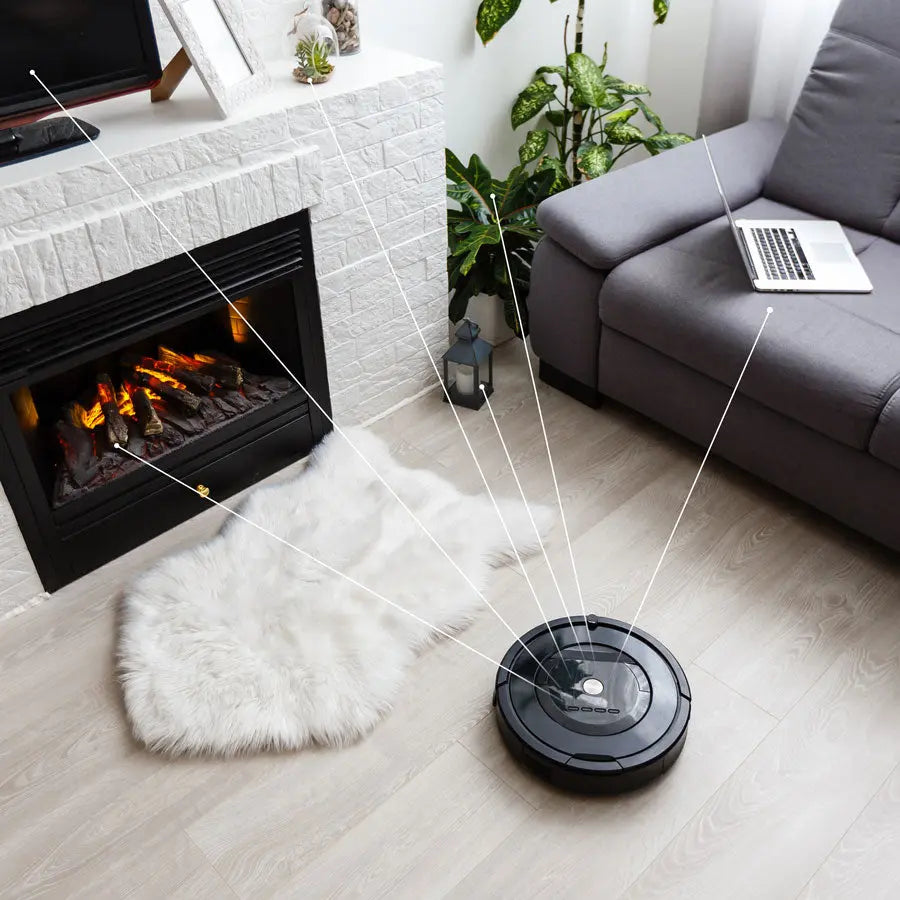Not sure where to start?
You are in the right place.

So you’ve decided to begin your journey toward becoming a proud robot vacuum owner with a cleaner home and more time for yourself. The decision you face now is, which vacuum to choose. This can be an overwhelming task given how many options there are available on the market today. Luckily, you have us to inform and guide you to the perfect vacuum for your cleaning needs and budget.
When choosing a robot vacuum, there are 6 things you will want to consider:
- Navigation- How well can the robot get around your home?
- Control- Can the robot be controlled by phone or manually?
- Mopping- Does the robot have a mopping feature? Primary, secondary, or equal to the vacuuming feature?
- Vacuuming capability- How much suction power? Dust bin size and brush design? Flooring types?
- Battery Life- How long can the battery last before recharge? Does the robot self-charge?
- Maintenance- How often does the robot require maintenance, such as replacing water and emptying dirt?

1. Navigation
Different vacuums vary dramatically in how well they can navigate. You can expect to pay more for more advanced navigation, but the most advanced navigation can also help robots to clean your home more efficiently and spare your walls and furniture from bumps. Here are some of the ways robot vacuums navigate to help you decide which is right for you:
Obstacle Avoidance
This is the most basic level of navigation that you can expect to find in a robot vacuum. Robot vacuums with obstacle avoidance have sensors to help them tell when they are about to bump into something and avoid the obstacle. They may not be nearly as good at avoiding obstacles as robots with more extensive mapping capabilities, since they can't tell that an obstacle is in front of them until they are quite near and may miss it entirely if their sensors don't pick up on it.
This means that these types of vacuums may be more likely to bump into things. Furthermore, vacuums that just have basic obstacle avoidance may not be nearly as efficient at navigating your space, so they may be more likely to go over the same space repetitively or miss some areas altogether.
These robots typically cannot have barriers or no-go spaces set and they are unable to return to their docking station to charge automatically. Some of them can sense darkness so that they will at least find their way out from under furniture, making them easier for you to find and recharge.
Obstacle Avoidance With Docking
These robots are very similar to robots featuring simple obstacle avoidance, with the added advantage that they can find their way back to the docking station. This can make a big difference since it means that you can set your robot and go about your business with the confidence that it will find its way back to the docking station and recharge itself as needed. That means that you will always have a charged robot on hand to deploy without having to worry about bringing it back to its docking station for charging.
Laser Mapping
Laser mapping is the most advanced level of navigation. There is some variation in how well different robots use their lasers to map. The best laser mapping on the market is the LiDAR SLAM system. SLAM without LiDAR is very good as well, but not quite as good.
LiDAR uses laser sensors to map out a room so that it will understand how the room is laid out well before it gets to obstacles. It can work with or without light. SLAM also maps out the room, but does so visually so that it requires light, and it is typically not as accurate as a LiDAR system.
Laser mapping robots vary in their effectiveness depending on how many lasers they deploy and where on the robot the lasers are mounted. In general, the more lasers, the better. LiDAR SLAM will come at the highest cost, while SLAM alone may be more affordable.
You can expect these sorts of robot vacuums to be able to communicate their maps to an app, which will then enable you to set no go zones, barriers, clean by room, etc. Some are better at detecting very small obstacles than others, so if you don't want to have to declutter before you run the vacuum, look carefully at how good a given vacuum with laser mapping is at avoiding small obstacles.
2. Control
How you control your robot vacuum is an essential aspect of how you will communicate with it and the role it will play in your life. Vacuums that give you more control enable you to use them as a nearly autonomous cleaning robot that will deploy on a schedule, charge itself, and avoid spaces as requested without you having to do anything after you have initially set your preferences. Vacuums with less control may enable you to set very basic functions about how they run but may need you to deploy them each time and may not allow you to set areas where you want them to go or avoid.
Higher-quality robots will allow you to control them using an app. These robots can often tie into smart devices like Google or Alexa to give you voice control as well. Often, a remote is offered as well as an alternative to the app if you would rather not use it or you don't have a smart device.
Robots that only offer a remote typically don't give you as much control as robots with an app. On the lower quality range are robots that must be manually controlled with buttons directly on the device. To give you an idea of what app control can mean to your experience with your robot, here are a few of the things you can expect your app to give you control over:
Not every robot or app will give you all of the above options. However, you can expect to find many of the things on this list in a very quality robot with app control. Robots vary in how well the app works. Some apps have trouble connecting to your home router or to the robot. Sometimes voice control functions don't work as well as they should. That said, in general, robots that are advertised to have app functionality will give you much more control over how your robot functions than robots that do not work with an app.
3. Mopping
As you are researching the robot vacuum that you want, you will inevitably stumble onto the question of whether a mopping function is important to you. Many robot vacuums do not offer mopping features. Others offer some mopping of limited functionality. Others offer excellent mopping but no vacuuming. A select few offer a good balance of mopping and vacuuming. Deciding what matters to you is important in helping you determine which robot is right for your needs.
Types of Mopping Vacuum
Primarily Vacuum With Some Mopping Functionality
These vacuums typically have a small water compartment that wets a mopping pad that is fixed to the bottom of the vacuum. Water can either seep out continuously to wet the pad or it can be adjusted according to your setting preferences. When the pad is dirty, it will need to be manually removed from the robot and changed or cleaned.
Mopping and Vacuuming
These robots generally work by using a dirty and clean water tank. Clean water is put out onto your floor, the floor is scrubbed with mopping pads, and dirty water is sucked back up into the vacuum. These robots work to vacuum and mop simultaneously, sucking up debris into the dirty water tank.
The most advanced varieties of these robots automatically clean the mops at a docking station so that you won't have to worry about cleaning the mops yourself. Usually, the only maintenance that these will require on a regular basis is emptying the dirty water tank and refilling the clean water tank.
Mopping Only
This kind of robot does not suck dirty water back up, but only puts out water and then uses it to mop the floors. Typically, the mops will need to be removed and cleaned between mopping sessions.
Features to Consider
Can You Add Detergent?
When you mop your floors manually, adding detergent is probably part of your routine. However, the majority of robot vacuum mops don’t allow you to add any kind of soap or detergent. They put out just water and use the force of the scrubbing brush to clean the floors.
Some robots that are more dedicated mopping machines do allow you to add detergent, sometimes only a specific detergent that comes with the mop and sometimes the detergent of your choice. If you want mopping that is similar to what you would do by hand, you'll want a robot that lets you add detergent. On the other hand, you may be surprised by just how effective water-only mopping robots can be.
Can You Adjust the Amount of Water That Comes Out?
Some mops automatically seep out an amount of water to wet the mop continuously. Sometimes these can be very effective, but at other times they won't seep out enough water for the mopping function to work. Sometimes they will put out too much water, leaving wet spots on your floor after the robot has gone by.
More advanced mopping robots allow you to choose how much water the mop puts out. These mops tend to be more consistent in their water output as well as allowing you to choose how much water to use.
Are Mobs Automatically Cleaned?
The most advanced mopping robots return to a docking station where the mops receive a certain level of automatic cleaning. The best of these also dry the mops so that they won't develop a mold or mildew smell as they are sitting in the docking station. You can expect to pay considerably more for robots that automatically clean their mops, but it can be a big difference in the amount of maintenance you need to do to not need to worry about removing the mop heads and cleaning them after every mopping cycle.
For any mop that does not automatically clean itself, you can expect removing the mop heads and washing them by hand or tossing them in the washing machine to be a part of maintenance after every or nearly every cycle.
4. Vacuuming Capability
You are in the market for a robot vacuum, so naturally, you want it to vacuum well. However, there is a compromise to be made between the cost of the robot and its suction power. Furthermore, there are a number of elements that go into how well a vacuum can suck up debris.
Suction
Robot vacuums vary between around 1500 and 4000Pa. Pa stands for Pascal Pressure Unit. The higher the number, the more suction power the vacuum is capable of. On the other hand, more intense suction power also typically means the vacuum will be louder and drain the battery more quickly.
Since most people run their robot vacuums regularly for everyday dust and small debris, high levels of suction power may not be as important as you initially assume. You may be surprised by just how well vacuums can suck up most everyday debris on lower levels of Pa.
On the other hand, if you have very thick carpet or a household that tends to get dirty quickly, higher levels of Pa may be very desirable for you. In general, you'll pay more for greater suction power. Don't feel like you are locked into the suction power that you choose when you go for higher levels, since the vast majority of robot vacuums give you the option of choosing the suction power you want so that you can choose a lower level as desired to save on battery and to reduce noise.
Design
The way that a vacuum is designed has important effects on its suction ability, regardless of how many Pa it has. The structure of the brushes, how many passes the vacuum makes, and how efficient the vacuum is in how it covers your home will all affect how much debris is left on the floor after the vacuum has been run.
Brushes that utilize both rubber and bristle components are often more effective at picking up both pieces of debris and hair, while rubber alone may be better at hair but not as good at debris and bristle alone may be better at just debris but not hair. Brushes that have both bristle and rubber may be more likely to catch hair up in the brush so that while it will get picked up, you also need to do tangle it later.
Spinning brushes on the side of the robot channel dirt and debris towards the vacuum mouth, enabling the vacuum to suck up more debris in corners and along edges. Some vacuums have two of these and some have one. If the brushes spin too quickly, they can tend to scatter debris instead of sending it towards the mouth of the vacuum, which can actually make the vacuum less effective rather than more effective.
Type Of Floor
Most floors involve some hard flooring and some carpet. Unfortunately, most vacuums work slightly better on either hard floors or carpet. Very few are equally effective at both. The best vacuums can automatically sense when they are moving over carpet and will automatically increase their suction power. Some vacuums also allow you to tell them where the carpeting is so that they will adjust suction power over these areas.
In general, it takes greater suction to pull up debris from carpet than it does to get debris on hard floors. The vacuums that do the best on hard floors typically adjust the level of the brush to meet the floor, providing a tighter seal between suction and floor and result in greater debris pickup.
Vacuums with side brushes that spin quickly can be very helpful for loosening up debris on carpet but may tend to scatter debris on hard floors. When deciding which vacuum is right for you, consider how much carpeting versus hard floors you have to help you decide what is most important to you in a vacuum.
Multiple Floors
If you have multiple floors in your home or you want to travel with your vacuum from one location to another and you are shopping for a vacuum with mapping functions, you will be somewhat limited in the number of vacuums you have to choose from.
Only a certain selection of high-quality vacuums are able to remember more than one floor layout. This is important because if the vacuum only remembers one floor layout it will need to remap every time it is set on a new floor, which means that you also need to reset no-go zones, barriers, etc. Therefore, if you're shopping for a mapping vacuum and have multiple floors, be careful to choose one that can support and remember more than one map.
Size of Dustbin or Auto Empty
How big the dustbin is has a direct consequence for how often you need to empty the vacuum. If you want more autonomy from your vacuum, you will choose a larger dustbin. If you want the most autonomy possible, you'll choose a vacuum that automatically empties itself into a bag at the docking station.
With some of the best of the automatically emptying vacuums, you may need to empty the bag only once a month or once every couple of months, which means that your vacuum really can run as an independent robot without you having to do much to help. Needless to say, you'll spend more for a vacuum that automatically docks and empties itself than for one with a self-contained bin that you need to empty.
Depending on how dirty your home is, you may need to empty the dustbin more or less frequently. Vacuums vary dramatically in how big their dustbins are and therefore how much debris the dustbin can hold before you need to empty it. In short, if you don't mind doing a little maintenance for the vacuum every time or every couple of times that it runs, you won't mind a smaller dustbin. However, if you want a robot that is as close to autonomous as possible, you'll want to choose a vacuum that automatically empties into the docking station.
Filter
All robot vacuums have a filter to catch debris and keep it from going back out into the air. If you have chosen to run a robot vacuum to eliminate allergens, a very effective filter will be even more important to you. A HEPA Filter is the gold standard for eliminating dust and allergens from the air as it goes through your vacuum.
Some vacuums also feature a complex dustbin design that helps to trap more debris and dust before it gets to the filter so that you won't need to change or clean the filter as often. Some filters can be cleaned several times before they need to be discarded, while other filters need to be replaced more regularly.
Noise level
All robot vacuums make some level of noise, typically much less than you would expect from a traditional vacuum. The more suction power a vacuum has, the greater noise you can expect. Most vacuums that offer high suction power give you the option of choosing a lower suction power as desired. Choosing lower suction power reduces the noise and saves on the battery.
The noise level of robot vacuums is typically measured in decimals. Around 40 or 50 decimals is considered fairly quiet, while over 70 decimals is a more noticeable sound level. Some robot vacuums feature special features like sound-absorbing cotton to reduce the noise level even for robots with significant suction power, but in general, you will see a trade-off between suction power and noise level. Mopping robots that don’t vacuum are often considerably quieter since the only sound produced by them is the noise from the motor used to rotate the brushes.
5. Battery life
Robot vacuums can vary pretty dramatically in the length of time that they are able to run on a single charge, from around an hour and a half to over three hours. Not surprisingly, you can expect to pay more, on average, for higher battery life.
However, the straightforward battery life is not the only consideration to be made when you are considering how autonomous this vacuum will be in running. Vacuums that automatically dock when they need to recharge and resume once they are fully charged can do a great job of keeping your home clean even if they do not have a huge amount of battery power on a single run. On the other hand, vacuums that must be manually charged will require a lot of interference from you in order to keep your home clean.
6. Necessary Maintenance
Robot vacuums save you a lot of work, but they don't completely eliminate the necessary maintenance required to keep them in working order. All vacuums need to have their filters changed, brushes or mops cleaned or changed, and their dustbins emptied periodically.
Vacuums that automatically empty the dustbin into a self-contained bag which you can throw out once a month or once every several months will save you a lot of work in cleaning, while vacuums with small dustbins may need to have their dustbin changed out every use or every other use.
Brushes that are designed to send hair into the dustbin don't need to have the hair cleaned out of them as often as brushes that don't. Some vacuums feature an auto-clean function in which they will increase suction power in order to pull hair and debris out of their brushes, but these are rarely infallible, and you will likely need to occasionally pull the hair and debris out anyways.
Think carefully about the overall sum of maintenance that a given vacuum will require from you before making your final decision. Some vacuums, particularly some mopping vacuums, may require nearly as much maintenance to keep the vacuum clean as you are otherwise spending on doing the vacuuming or mopping yourself, which some people find to contradict the entire purpose.
Enjoy the Perfect Robot Vacuum for Your Home
It takes some research to choose the right robot vacuum for you, but by thinking carefully about your needs and weighing the pros and cons of various models, you have a very good chance of choosing a robot vacuum that will work perfectly for your home.
Keep in mind that the right robot vacuum for one person is rarely perfect for another person. Details of your home including how dirty it tends to get, how much carpeting versus hard floors you have, and how many floors you have all affect which robot vacuum you should choose.





